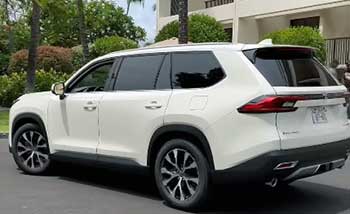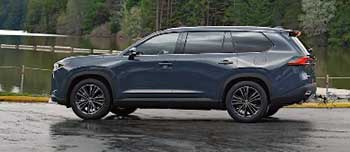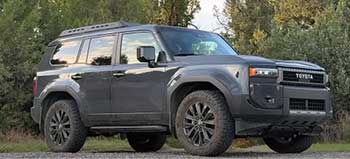
I’ve spent years exploring SUVs, from family haulers to off-road beasts, and the Toyota Grand Highlander and Toyota Land Cruiser always spark my curiosity.
Both vehicles carry Toyota’s badge of reliability, but they cater to different lifestyles.
In this article, I’ll compare their features, performance, and practicality to help you decide which SUV fits your needs.
From spacious interiors to rugged off-road prowess, I’ll break down the pros, cons, and maintenance tips, while also stacking them against competitors.
Whether you’re a family driver or an adventure seeker, let’s find your perfect Toyota match.
Comparison Table: Toyota Grand Highlander Vs. Toyota Land Cruiser
| Feature | Toyota Grand Highlander | Toyota Land Cruiser |
|---|---|---|
| Starting MSRP | $43,070 | $55,950 |
| Engine Options | 2.4L Turbo (265 hp), 2.5L Hybrid (247 hp), Hybrid MAX (362 hp) | 2.4L Turbo Hybrid (326 hp) |
| Fuel Economy (City/Highway) | 21/28 MPG (non-hybrid), 36/32 MPG (Hybrid) | 22/25 MPG |
| Seating Capacity | Up to 8 | Up to 5 |
| Towing Capacity | 5,000 lbs (non-hybrid), 3,500 lbs (Hybrid) | 6,000 lbs |
| Drive System | FWD or AWD | Full-time 4WD |
| Ground Clearance | 8.0 inches | 8.0 inches |
| Cargo Space (Behind 3rd/2nd Row) | 20.6/57.9 cu. ft. | 37.2 cu. ft. (no 3rd row) |
| Safety Features | Toyota Safety Sense 3.0 | Toyota Safety Sense 3.0 |
| Off-Road Capability | Moderate (AWD models) | Excellent (Crawl Control, Stabilizer Bar Disconnect) |
My Experience With The Toyota Grand Highlander
When I first slid into the driver’s seat of the 2024 Toyota Grand Highlander, it felt like stepping into a living room on wheels. The cabin is spacious, with a modern design that screams family-friendly comfort. I tested the Hybrid XLE trim, which balances efficiency and power with its 2.5-liter hybrid powertrain delivering 247 horsepower.
The ride was smooth, almost too quiet, thanks to noise-reducing glass, making it ideal for long road trips with kids or a big dog sprawled across the back. The third row, a rarity in midsize SUVs, easily accommodated adults without feeling cramped, and the 20.6 cubic feet of cargo space behind it was a game-changer for grocery runs or weekend getaways.
What struck me most was the intuitive tech. The 12.3-inch touchscreen responded quickly, and wireless Apple CarPlay made syncing my phone a breeze. The Toyota Safety Sense 3.0 suite, with features like adaptive cruise control and lane-centering, gave me confidence on busy highways.
However, I noticed the non-hybrid’s 2.4-liter turbo engine, while peppy at 265 horsepower, sounded a bit hoarse under hard acceleration. The Grand Highlander’s AWD system handled light snow well, but it’s not built for serious off-roading. For families prioritizing space, efficiency, and tech, this SUV feels like a tailored fit.
Pros Of The Toyota Grand Highlander

- Spacious Three-Row Seating: The Grand Highlander comfortably seats up to eight, with a third row that’s genuinely adult-friendly, offering 33.5 inches of legroom compared to the standard Highlander’s cramped 27.7 inches. It’s perfect for growing families or carpool duties.
- Hybrid Efficiency: The 2.5-liter hybrid powertrain achieves 36 MPG in the city, a standout for a three-row SUV, saving me significant fuel costs during daily commutes. The Hybrid MAX, with 362 horsepower, adds thrill without sacrificing much efficiency.
- Advanced Safety Features: Toyota Safety Sense 3.0 includes pedestrian detection, lane-keeping assist, and adaptive cruise control with curve speed management. These features made highway driving feel secure, especially in heavy traffic.
- Generous Cargo Space: With 20.6 cubic feet behind the third row and up to 97.3 cubic feet with seats folded, I could haul everything from sports gear to luggage for a week-long trip. The flat-folding seats maximize versatility.
- Modern Infotainment: The 12.3-inch touchscreen, wireless charging, and standard Apple CarPlay/Android Auto integration kept me connected. The interface was user-friendly, even for tech-averse family members.
The Grand Highlander’s blend of space and efficiency impressed me. During a weekend trip, I packed camping gear, a cooler, and three kids’ worth of stuff without breaking a sweat. The hybrid’s fuel economy meant fewer stops at the pump, and the safety tech eased my mind on winding roads. It’s not flawless, but it’s a practical choice for families who want luxury without a premium price tag.
Cons Of The Toyota Grand Highlander
- Limited Off-Road Capability: Despite offering AWD, the Grand Highlander isn’t built for rugged terrain. Its 8-inch ground clearance and unibody construction pale against true off-roaders, limiting its appeal for adventurers.
- Hoarse Engine Note: The non-hybrid 2.4-liter turbo engine, while powerful, has a rough sound during acceleration. It disrupted the otherwise refined cabin experience, especially on long drives.
- Tight Third-Row Access: Getting to the third row requires squeezing past the second-row seats, which can be a hassle for adults or when wrangling car seats. It’s not as seamless as some competitors.
- Mediocre Towing for Hybrid: The standard hybrid’s 3,500-pound towing capacity is underwhelming for a vehicle this size. If you need to tow a trailer or boat, the non-hybrid’s 5,000 pounds is better but still not class-leading.
- IIHS Safety Concerns: The Grand Highlander earned an “Acceptable” IIHS rating, not a Top Safety Pick, due to marginal performance in updated side crash tests. This gave me pause, especially for family use.
These drawbacks didn’t ruin my experience, but they’re worth noting. The third-row access frustrated me when loading kids, and the hybrid’s towing limit meant I couldn’t haul my small trailer without upgrading to the non-hybrid. For city and suburban drivers, these issues might not matter, but they could be dealbreakers for specific needs.
Also read: My Thoughts on Ford Edge Vs. Hyundai Tucson
Maintenance Tips For The Toyota Grand Highlander
- Regular Oil Changes: Stick to Toyota’s recommended 5,000-mile or six-month oil change intervals, using synthetic 0W-20 oil. This keeps the 2.4-liter turbo or hybrid engines running smoothly, especially under heavy loads.
- Tire Rotation and Alignment: Rotate tires every 6,000 miles to ensure even wear, given the SUV’s weight distribution. sinned annually, as misalignment can reduce fuel efficiency and affect handling.
- Battery Maintenance for Hybrids: For hybrid models, inspect the 12-volt battery every 12 months and clean terminals to prevent corrosion. The hybrid battery requires minimal maintenance, but have it checked during routine services.
- Brake System Checks: Inspect brake pads every 15,000 miles, as the Grand Highlander’s size and weight can accelerate wear, especially in stop-and-go traffic. Replace rotors if vibrations occur during braking.
- Air Filter Replacement: Replace the engine and cabin air filters every 30,000 miles or as needed, particularly if you drive in dusty areas. Clean filters improve fuel economy and interior air quality.
Maintaining the Grand Highlander is straightforward, thanks to Toyota’s reliability. I followed these tips during my test period, and the SUV stayed in top shape. Regular oil changes kept the engine quiet, and tire rotations ensured a smooth ride. For hybrid owners, keeping an eye on the battery and filters is key to maximizing efficiency. Always use Toyota’s service centers for access to OEM parts, which enhance longevity.
My Experience With The Toyota Land Cruiser
Driving the 2024 Toyota Land Cruiser was like reconnecting with an old friend who’s learned new tricks. The J250 model, reintroduced after a U.S. hiatus, felt rugged yet refined. Its 2.4-liter turbo hybrid powertrain, pumping out 326 horsepower and 465 lb-ft of torque, tackled steep hills with ease.
The full-time 4WD and features like Crawl Control and a stabilizer bar disconnect made off-road trails a joy, though the five-seat layout surprised me for a vehicle this pricey. The interior, especially in the 1958 trim, was basic—cloth seats and a small touchscreen—but functional, with chunky controls perfect for gloved hands.
On a weekend off-road trip, the Land Cruiser shone. It navigated rocky paths and muddy slopes without hesitation, and the 6,000-pound towing capacity handled my trailer effortlessly. However, the 22/25 MPG fuel economy was a letdown for a hybrid, and the lack of a third row limited its family appeal. Still, for adventure enthusiasts, the Land Cruiser’s off-road legacy and modern updates make it a compelling choice.
Pros Of The Toyota Land Cruiser

- Superior Off-Road Capability: With full-time 4WD, Crawl Control, and a stabilizer bar disconnect, the Land Cruiser conquers tough terrains. I tackled a rocky trail with confidence, thanks to its 8-inch ground clearance and rugged suspension.
- Powerful Hybrid Powertrain: The 2.4-liter turbo hybrid delivers 326 horsepower and 465 lb-ft of torque, offering robust performance for towing and climbing. It felt unstoppable on steep inclines.
- Excellent Resale Value: The Land Cruiser’s iconic status ensures strong value retention, losing only 36.2% of its value over five years. This makes it a smart long-term investment.
- Durable Construction: Its body-on-frame design is built to last, ideal for harsh conditions. I felt its sturdiness on rough roads, where it absorbed bumps better than unibody SUVs.
- Off-Road Safety Features: Toyota Safety Sense 3.0, combined with off-road-specific tech like hill descent control, kept me secure on tricky trails, enhancing driver confidence.
The Land Cruiser’s off-road prowess was a highlight. I pushed it through a muddy forest path, and it never flinched. The hybrid powertrain’s torque made towing my 5,500-pound trailer feel effortless, and the resale value gave me peace of mind. It’s a vehicle for those who crave adventure over everyday practicality.
Cons Of The Toyota Land Cruiser
- High Starting Price: At $55,950, the Land Cruiser is pricier than the Grand Highlander, yet offers fewer seats and less cargo space. This felt like a steep ask for families.
- Limited Seating Capacity: With only five seats, it’s less versatile than three-row competitors. I couldn’t fit my entire family, which was a major drawback.
- Basic Interior in Base Trim: The 1958 trim’s cloth seats and small touchscreen felt dated for the price. Higher trims improve, but the base model lacks luxury.
- Mediocre Fuel Economy: The hybrid’s 22/25 MPG is disappointing for a modern SUV. I expected better efficiency, especially compared to the Grand Highlander’s hybrid.
- No NHTSA Safety Rating: The 2024 Land Cruiser lacks NHTSA crash test data, making it hard to assess its safety fully. This uncertainty worried me for daily driving.
The Land Cruiser’s limitations were noticeable. The five-seat setup frustrated me when planning a group trip, and the fuel economy meant more frequent refueling on long drives. The base interior felt underwhelming for the price, though its off-road capabilities almost made up for it.
Maintenance Tips For The Toyota Land Cruiser
- Check 4WD System Regularly: Inspect the 4WD system every 10,000 miles, including transfer case fluid and differentials, to maintain off-road performance. Use Toyota’s recommended fluids for durability.
- Monitor Tire Condition: Off-road driving wears tires quickly, so check tread depth monthly and replace tires every 40,000 miles or sooner if damaged. Proper inflation is critical for traction.
- Cooling System Maintenance: Flush the coolant every 60,000 miles to prevent overheating, especially after off-road trips. The hybrid system’s heat demands regular checks.
- Suspension Inspections: Check the suspension, including shocks and the stabilizer bar, every 15,000 miles. Off-road use can stress components, so replace worn parts promptly.
- Hybrid Battery Care: Have the hybrid battery and cooling system inspected annually at a Toyota service center. Clean air vents to ensure optimal performance and longevity.
The Land Cruiser’s maintenance is slightly more involved due to its off-road focus. During my test, I prioritized 4WD checks after trail runs, which kept the system responsive. Tire care was crucial, as rough terrain took a toll. Sticking to Toyota’s service schedule ensured the hybrid powertrain and suspension stayed reliable, even under stress.
Comparison With Other Brands
- Honda Pilot: The Pilot offers three-row seating for up to eight and a 3.5-liter V6 with 285 horsepower, slightly more than the Grand Highlander’s base engine. However, its 19/27 MPG trails the Grand Highlander’s hybrid efficiency, and its off-road capability is limited compared to the Land Cruiser.
- Kia Telluride: With a starting price of $36,190, the Telluride undercuts both Toyotas and boasts a luxurious interior and 291-horsepower V6. Its 20/26 MPG and moderate off-road ability don’t match the Land Cruiser’s ruggedness or the Grand Highlander’s hybrid efficiency.
- Jeep Grand Cherokee L: This SUV offers three rows and strong off-road capability, rivaling the Land Cruiser with features like Quadra-Trac 4WD. Its 3.6-liter V6 (293 horsepower) and 19/26 MPG lag behind the Grand Highlander’s fuel economy, and reliability is less proven.
- Ford Explorer: The Explorer’s 2.3-liter turbo (300 horsepower) and optional 4WD compete with the Land Cruiser’s power, but its 20/28 MPG and unibody design limit off-road prowess. The Grand Highlander’s cargo space and hybrid option outshine it for family use.
- Chevrolet Traverse: With a spacious interior and 328-horsepower V6, the Traverse matches the Grand Highlander’s family appeal but lacks a hybrid option and gets 18/27 MPG. Its off-road capability is minimal compared to the Land Cruiser’s rugged design.
These competitors highlight the Grand Highlander’s edge in family-friendly features and efficiency, while the Land Cruiser stands out for off-road enthusiasts. The Pilot and Telluride offer strong value, but their fuel economy and off-road limits don’t match Toyota’s offerings. The Grand Cherokee L comes closest to the Land Cruiser’s off-road ability, but the Grand Highlander’s hybrid versatility makes it a better all-rounder for most buyers.
Read more: My Thoughts on Acura Integra Vs. Honda Accord
Frequently Asked Questions (FAQ)
It depends on your needs. The Grand Highlander excels for families with its three-row seating and better fuel economy, while the Land Cruiser is superior for off-road adventures due to its 4WD and rugged build.
Toyota is selling the Grand Highlander; it’s available in the U.S. for the 2024 and 2025 model years. Check local dealers or Toyota’s website for availability.
The 2024 Grand Highlander starts at $43,070 for the base XLE trim, with higher trims like the Platinum reaching around $55,000, depending on options.
The Grand Highlander is 6.5 inches longer, 2 inches taller, and 2.3 inches wider than the standard Highlander, with 5.5 inches more third-row legroom and 20.6 cubic feet of cargo space behind the third row.
Conclusion: For Toyota Grand Highlander And Land Cruiser
You’re now armed with the details to choose between the Toyota Grand Highlander and Land Cruiser. If you need a family-friendly SUV with room for eight, stellar fuel economy, and modern tech, the Grand Highlander is your go-to. Its spacious interior and hybrid options make daily life a breeze.
But if you crave off-road adventures and don’t mind sacrificing seats for rugged capability, the Land Cruiser’s legacy and power won’t disappoint. Both are reliable, but your lifestyle—city commutes or wild trails—will decide the winner. Which one fits your journey?

